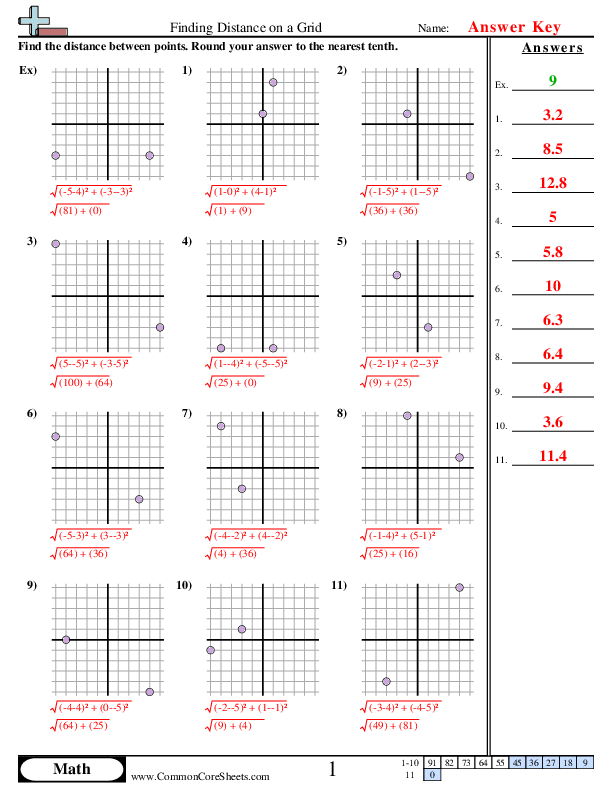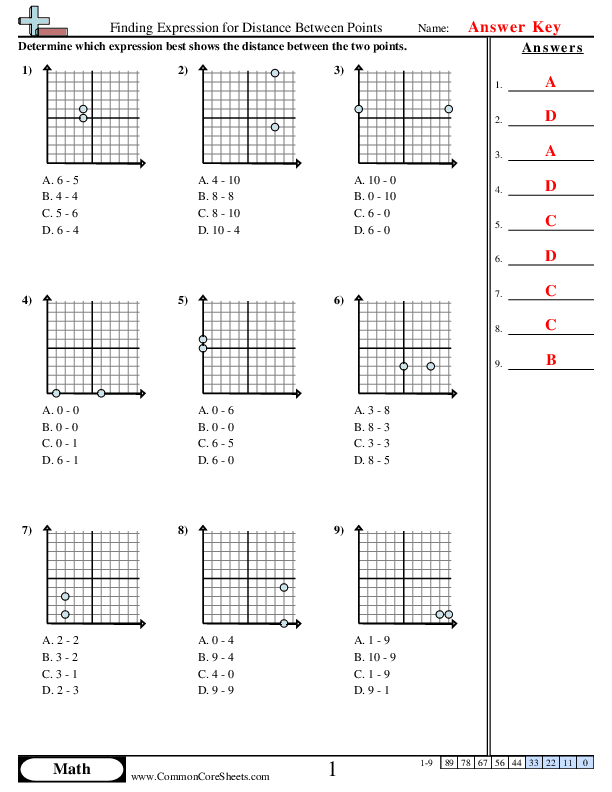Our graphing worksheets are the best on the internet for helping students learn how to graph data and interpret the results. These free worksheets cover a wide range of topics, including graphing positive and negative coordinates, reading a coordinate plane and many more. Our worksheets are designed to be easy to use and understand, making them perfect for students of all ages. Whether you're a teacher looking for the best graphing worksheets to use in your classroom, or a student looking to improve your graphing skills, these worksheets are the perfect resource. So why wait? Start using our graphing worksheets today and see the difference they can make in your understanding of this important topic!
Browse Sheets By Problem Type
×

Finding Distance (Same X or Y)
6ns8


×
Description:
"This worksheet is designed to enhance children's understanding of distance calculation on a grid in mathematics. It provides 11 problem-solving tasks that guide kids through a step-by-step process of using coordinates to calculate distances. Tailored to accommodate different learning environments, the sheet can be customized for personal needs, converted into interactive flash cards, or integrated into distance learning curriculums to reinforce this crucial math concept in a fun and engaging way."

×
Student Goals:
Understanding Grid-Based CalculationsAfter completing this worksheet, students will have a better understanding of how to calculate distances within a grid. They'll have a better command of the mathematical concepts involved, bringing them closer to mastering the subject matter. Distance calculations on a grid are a critical part of mathematics and these exercises will immensely magnify their ability to handle them, pertinent to real-world applications like physical mapping, computer graphics, and data visualization.Problem Solving and Critical ThinkingBy successfully navigating through the problems in the worksheet, students will also develop enhanced critical thinking and problem-solving skills. Each task poses a unique challenge that requires careful consideration and mathematical reasoning. Thus, they will be capable of strategically tackling complex problems, developing a structured approach to break them down and derive solutions.: Proficiency in Mathematical OperationsThe worksheet addresses basic to advanced mathematical operations. Therefore, students will become more adept at executing these operations accurately and efficiently after multiple practices provided by the worksheet. Their proficiency in addition, subtraction, multiplication, and square operations will be noticeably improved.Applying Mathematical ConceptsThrough applying mathematical concepts to solve distance problems on grids, students will better understand and learn abstract mathematical ideas. Despite being simple arithmetic, the worksheet allows the students to understand the fundamentals of the coordinate system, geometry, and how to use two-dimensional spaces with ease.Enhancement of Math VocabularyIn the process of completing this worksheet, students will come across various key terms and symbols regularly used in mathematics. This exposure can lead to an expanded vocabulary in math language, enabling them to articulate mathematical problems better in the future.Confidence in MathSuccessfully completing the worksheet will help students build confidence in their mathematical abilities. Overcoming challenges and solving problems on their own will give them the confidence to approach even more complex math problems in the future, reducing math-anxiety, and cultivating a positive attitude towards the subject.



Finding Distance (Different X and Y)


×
Description:
"This worksheet is designed to teach children how to calculate distances on a grid using mathematic equations. It consists of 11 targeted math problems, effectively teaching the concept through practical application. Versatile in its purpose, it can be customized to fit varying levels of problem-solving proficiency, converted into flash cards for interactive learning or utilized in a distance learning environment for flexible mathematical education."

×
Student Goals:
Understanding of Mathematical ConceptsAfter completing the worksheet, students will deepen their understanding of mathematical concepts, such as the importance of coordinates and their relationship in determining distance on a grid. The exercises involve the use of Pythagorean theorem, enhancing their comprehension of geometrical principles and their applications.Enhanced Problem-Solving SkillsThe problems presented in the worksheet require logical thinking and reasoning. Students will be able to enhance their problem-solving skills by translating real-world concepts into a mathematical framework. They will master skills such as breaking down complex problems into simpler, more manageable parts and applying mathematical rules to solve them.Improved Numerical SkillsThe worksheet provides plenty of practice for students to work on their numerical skills. These tasks will improve the students' comfort and fluency with numbers, strengthening their ability to make quick and accurate calculations, a skill that is crucial in many areas of life beyond math.Familiarity with Grid SystemsGrid systems are ubiquitous, used in a variety of contexts from maps to spreadsheets. By finding distances on a grid system in this worksheet, students will become more familiar with the use and interpretation of grids which is a transferrable skill for fields such as data management, engineering, and navigation.Promotion of Logical and Structural ThinkingThe worksheet promotes logical and structural thinking by requiring students to apply a systematic method to solve the problems. By methodically applying mathematical formulas to find distances on a grid, students will improve their ability to think logically and in a structured manner.Ability to Work IndependentlyBy working through the exercises in the worksheet, students will improve their ability to work independently. They will familiarize themselves with strategies for approaching and solving mathematical problems, fortifying their confidence in their own abilities to work through challenges on their own.



Determining Horizontal or Vertical Lines by Coordinates


×
Description:
"This worksheet is designed to help children master the concept of determining horizontal or vertical lines by coordinates. It contains 20 math problems based on pairs of coordinates. Versatile and adaptable, it can be customized to suit individual learning needs, converted into flashcards for practice, or utilized as part of distance learning programs."

×
Student Goals:
Understand Coordinates and LinesBy completing the worksheet, students will deeply understand the concept of coordinates and how to determine whether lines are horizontal or vertical. They will enhance their knowledge of the coordinate plane and strengthen their understanding of points, lines, and angles.Practice Problem SolvingThe worksheet will improve students' problem solving and reasoning skills as they learn to navigate through different sets of coordinates. This practice will enable them to identify patterns and deduce whether the line formed by two coordinates is horizontal or vertical, helping them develop critical thinking capabilities.Boost Mathematical SkillsTackling the problems in the worksheet equips the students with a strong foundation in mathematics. Their numeracy skills are reinforced as they regularly work with numbers and symbols. They will also learn important concepts in geometry that are instrumental for their academic progress in the math field.Enrich Real-life Application of MathAfter completing the worksheet, students will be equipped with the fundamental skills needed to apply their mathematical knowledge to real-world situations. Understanding coordinates and lines could be beneficial in various areas such as map reading, programming, and even in arts and engineering.Enhance Spatial AwarenessBy identifying whether lines are vertical or horizontal, the students will foster their spatial awareness skills. This understanding allows students to visualize objects from different angles and helps in many areas such as reading graphs, understanding blueprints, or visualizing geometric shapes.Improve Analytical SkillsWorking through the worksheet will also refine the students' analytical skills. Identifying patterns and drawing conclusions from the given sets of coordinates requires a systematic approach to problem solving, and the practice of these skills will be beneficial in many other academic subjects.



Finding Expression for Distance Between Points


×
Description:
"This worksheet is designed to strengthen children's math skills, focusing specifically on finding the expression for distance between points. It includes 9 customized problems that test and develop their comprehension through practical examples. Future adaptability allows the worksheet to be converted into flashcards or incorporated into distance learning programs, ensuring flexibility in learning and reinforcing core mathematical concepts."

×
Student Goals:
Understanding Mathematical ConceptsAfter completion of the worksheet, students should have an understanding of key mathematical elements. They should be able to appreciate the principles involved in the concept of distance between two points, which forms a foundational Math concept for complex topics in higher grades. They should understand how arithmetic operations like subtraction are used in determining distances, and be comfortable dealing with positive and negative numbers.Developed Problem-solving SkillsThe worksheet also aims to improve students' problem-solving abilities. The nature of the questions requires them to apply cognitive skills and logic to find the correct answers. By tackling these problems head-on, students should be able to sharpen their critical thinking skills further, which can be applied to more complex mathematical problems and to different situations outside the classroom.Enhanced Mathematical Accuracy and SpeedThrough completing this worksheet, students should improve their accuracy in mathematical computation. The repetitive practice of similar types of problems will help students to minimize errors in calculations. This enhanced accuracy, combined with better speed in conducting task-related operations, is expected to improve their overall performance in mathematics.Foster Confidence and Self-EfficacySuccessfully completing the worksheet will give the students a sense of accomplishment and confidence in their Math abilities. This self-driven accomplishment, in turn, boosts their self-efficacy. Understanding that they have the capability to tackle and successfully solve the problems will encourage them to approach new, possibly more complex, Math tasks with a positive mindset.Realize the Importance of PracticeLastly, students should understand the importance of repeated practice in mastering a concept. By working through each problem, they should start to recognize patterns and familiarize themselves with the process, leading to a deeper understanding of the concept. This practice is not only applicable in Math but in other learning areas and real-life scenarios as well.






